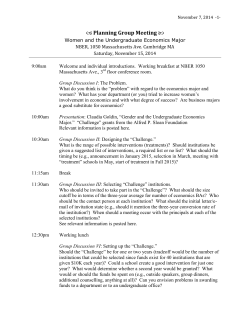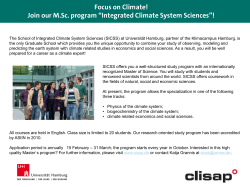
Environmental Economics and Policy
FRE 525 Environmental Economics and Policy Course Outline Class Time: Tuesday, Thursday 12:30 -1:50 PM Room: MacMillan: 154 Description In this course, we will build an analytical framework from simple economic principles. We will use it to define society’s optimal pollution and preservation/exploitation of natural resources. We will then ask: can markets function effectively to protect our environment or is government policy necessary? When it comes to the environment, the market often fails. What can we do to improve it? Based on the type of resource, we will study policies to correct market failure. We will understand the realities of government intervention and how government’s can do better in steering our environment. Based on the economic framework developed, we will study in detail the economics of climate change, marine resources, urban environmental issues including transportation and the environment, and energy. What you will learn ! The critical role of property rights, institutions, and incentives in environmental problems ! The various sources of market failure in real-world environmental situations. ! The relative merits of different environmental policies—market-based or other regulatory solutions—in different contexts. Instructor Sumeet Gulati Phone: (604) 822-2144 Office: 341 MacMillan Office Hours: Tuesday, Thursday 2:00 PM – 3:00 PM Besides my office hours, email (sumeet.gulati@ubc.ca.) is the best way to get in touch with me. Prerequisites 1) Intermediate microeconomic theory. 2) Basic differential and integral calculus. 3) Basic Regression Analysis. Course Requirements Students will take two exams: two midterms, and one final. The midterm will be held in class, lasting 80 minutes. The final exam will be comprehensive (it shall cover all material taught in class), and will last two (or more) hours. You must take exams at the scheduled times unless you have another exam at the same time, serious illness, or an emergency. You must validate with documentation the reason(s) why you will be unable to take any exam. There shall be six assignments. The first two assignments will problems based on material taught in class. The last four assignments will ask you to reuse your student blogs to write about a policy issue as instructed. Your grade shall be determined as follows Exams and Problem Sets First Midterm Best 5 from 6 Problem Sets Final Exam Date February 12th, 2015. Assigned every two weeks. To be announced. Percent of Grade 30 percent 30 percent 35 percent Class Participation Contributions to class discussions. 5 percent Your participation grade depends on your contribution to class discussions. All contribution is appreciated, even questions asking me to clarify previously taught material. The sole aim of assigning a participation grade is to encourage active learning for everyone. I will ascertain and assign this part. The class twitter discussion: Almost everyday, I shall tweet links or commentary to news and blog posts via my twitter page: https://twitter.com/sgulati. All material I consider relevant to this course will be marked with the hashtag: #mfre. You can contribute in two ways: 1) by providing your thoughts, or links to information relevant to this course, or 2) by commenting on what I, or your classmates, tweet. Academic Dishonesty Please review the UBC Calendar “Academic regulations” for the university policy on cheating, plagiarism, and other forms of academic dishonesty. Academic dishonesty will be dealt with very seriously in this course. Online Course Material Available at Webct Connect: http://www.connect.ubc.ca. You are required to regularly login to your course page for FRE 525. Your syllabus, course-lecture slides, additional material, announcements, assignments, and grades are available. Course Outline and Readings How to use this course outline: This outline is a collection of papers, and topics commonly taught in the economics of the environment. Wherever possible I provide a stable link to the paper. While some of these links will work anywhere, many of them are digitally protected requiring a subscription. You can access this material by logging in through your account at the UBC library, or on any computer connected via Ethernet on the UBC network. For some articles I do not provide a link, in that case, please search for the article (if you search via the UBC library you will find access to its electronic version). This outline is subject to change. I might add/replace material as the course proceeds. 1. Introduction to Environmental Economics (much of this material is for you to review yourself): a. Fullerton, D. and R. Stavins (1998), “How do Economists Really Think About the Environment?” Discussion paper 98-29, Resources for the Future, http://www.rff.org/documents/RFF-DP-98-29.pdf. b. Material listed in part b. will not be covered in class. You are required to review it yourself. There is course material on Connect for this section, please review your course slides up to and including the set of slides titled: Mineral Economics. This material will not be taught in class. Students can supplement the material on Connect by reading an undergraduate level environmental textbook of their choice. One suggestion is: Keohane and Olmstead, “Markets and the Environment,” Island Press, http://www.islandpress.com/ip/books/book/islandpress/M/bo5092233.html. You will be tested on the following topics in your first midterm (see Table above for a date): 1. Economic Efficiency. 2. Externalities and Market Failure. 3. Benefit-cost analysis and its relationship with efficiency. 4. Dynamic/Intertemporal Efficiency. 5. Mineral Economics/The Extraction of Depletable Resources. c. The economics of pollution control / Instrument choice in environmental policy. 1. Material in Connect: course slides titled “The Economics of Pollution Control” and “Ambient Standards.” 2. Lawrence H. Goulder and Ian W. H. Parry (2008),“Instrument Choice in Environmental Policy,” Rev Environ Econ Policy 2(2): 152-174 doi:10.1093/reep/ren005. Available online at http://reep.oxfordjournals.org/content/2/2/152.abstract. 2. Marine Resources/Open Access Resources. a. Course Material on Connect. b. Brown G. (2000) “Renewable natural resource management and use without markets”, Journal of Economic Literature, 38, 875-914. Economics of Fisheries c. Conrad, J.M. (1995), “Bioeconomic models of the fishery”, Handbook of Environmental Economics, (D. Bromley, ed.) Oxford, Blackwell, 405-432 d. Gordon, H.S. (1954), “The economic theory of a common property resource: the fishery”, Journal of Political Economy, 62, 124-142 Policy Problems e. Turner M.A., (1997), “Quota-induced discarding in heterogeneous fisheries” Journal of Environmental Economics and Management, 33, 186-195 3. The Economics of Climate Change. a. Some basic issues: Class material on Connect. b. Symposium: The Economics of Climate Change: The Stern Review and Its Critics. This is a symposium of four papers online at: http://reep.oxfordjournals.org/content/2/1.toc. Individual papers are: 1. Robert Mendelsohn (2008), “Is the Stern Review an Economic Analysis?” Rev Environ Econ Policy 2(1): 45-60 doi:10.1093/reep/rem023 2. Thomas Sterner and U. Martin Persson (2008), “An Even Sterner Review: Introducing Relative Prices into the Discounting Debate,” Rev Environ Econ Policy, 2(1): 61-76 doi:10.1093/reep/rem024. 3. John P. Weyant (2008), “A Critique of the Stern Review's Mitigation Cost Analyses and Integrated Assessment,” Rev Environ Econ Policy 2(1): 77-93 doi:10.1093/reep/rem022. 4. Simon Dietz and Nicholas Stern (2008), “Why Economic Analysis Supports Strong Action on Climate Change: A Response to theStern Review's Critics,” Rev Environ Econ Policy 2(1): 94113 doi:10.1093/reep/ren001. c. Evaluating Policy: An Example of Taxes versus Cap and Trade for Climate Policy 1. Aldy, J. E., E. Ley, and I. W. H. Parry (July 2008), “A Tax-Based Approach to Slowing Global Climate Change,” Resources for the Future Discussion Paper, RFF DP 08-26. 2. Olewiler, N. (November 2008), “A Cap and Trade System for Reducing Greenhouse Gas Emissions in BC,” Pacific Institute for Climate Solutions, Victoria, BC. 4. The Urban Environment. a. Kuminoff N. V., V. Kerry Smith, and C. Timmins (Dec 2013), “The New Economics of Equilibrium Sorting and Policy Evaluation Using Housing Markets,” Journal of Economic Literature, 51(4). b. Glaeser E. L., and M. E. Kahn (May 2010), “The greeness of cities: Carbon dioxide emissions and urban development,” Journal of Urban Economics, 67(3), 404-418. c. Gilles Duranton and Matthew A. Turner (October 2011), The fundamental law of road congestion: Evidence from the US, American Economic Review, 101(6):2616-52. 5. Transportation and the Environment. a. Overview 1. Alex Anas and Robin Lindsey (2011), “Reducing Urban Road Transportation Externalities: Road Pricing in Theory and in Practice,” Rev Environ Econ Policy 5(1): 66-88 doi:10.1093/reep/req019 2. Stef Proost and Kurt Van Dender (2011), “What Long-Term Road Transport Future? Trends and Policy Options,” Rev Environ Econ Policy 5(1): 44-65 doi:10.1093/reep/req022 3. Werner Antweiler and Sumeet Gulati (December 2012), “Environmental Tax Policies Towards Transportation in British Columbia” Canadian Tax Journal, 20(12). 4. Werner Antweiler and Sumeet Gulati (August 2013) “Market-Based Policies for Green Motoring in Canada,” Canadian Public Policy, 39 (2). b. Gasoline Prices/Taxes: 1. Christopher R. Knittel (Winter 2012), “Reducing Petroleum Consumption from Transportation,” Journal of Economic Perspectives, 26(1). 2. Busse, Meghan, Christopher R. Knittel and Florian Zettelmeyer (2011). “Pain at the Pump: The Differential Effect of Gasoline Prices on New and Used Automobile Markets.” Unpublished. c. Fuel Efficiency Standards 1. Soren T. Anderson, Ian W. H. Parry, James M. Sallee, and Carolyn Fischer (2011), “Automobile Fuel Economy Standards: Impacts, Efficiency, and Alternatives,” Rev Environ Econ Policy 5(1): 89108 doi:10.1093/reep/req021. d. Subsidizing new technology. 1. Chandra, Ambarish, Sumeet Gulati and Milind Kandlikar (September 2010), "Green Drivers or Free Riders: An Analysis of Tax Rebates for Hybrid Vehicles," Journal of Environmental Economics and Management, 60 (2), 57-144. 6. Energy. a. William D. Nordhaus, “Energy: Friend of Enemy”, The New York Review of Books, http://www.nybooks.com/articles/archives/2011/oct/27/energy-friend-or-enemy/?pagination=false. b. Richard Schmalensee (December 2011), “Evaluating Policies to Increase Electricity Generation from Renewable Energy” Rev Environ Econ Policy, doi:10.1093/reep/rer020. c. More Material to be added later. 7. International Environmental Issues – if time permits. Tentative Lecture Schedule (to be finalized). Do not consider right now. 1. Tue, January 6th, 2015 Introduction/Economics of Pollution Control 2. Thurs, January 8th, 2015 Pollution Control/Ambient Standards 3. Tues, January 14th, 2015 Ambient Standards 4. Thurs January 15th, 2015 Marine Resources 5. Tues, January 20th, 2015 Marine Resources 6. Thurs, January 22nd, 2015 Marine Resources 7. Tues, January 27th, 2015 Marine Resources 8. Thur January 29th, 2015 Marine Resources 9. Tues, February 3rd, 2015 Marine Resources 10. Thurs, February 5th, 2015 Climate Change 11. Tues, February 10th, 2015 Climate Change 12. Thurs, February 12th, 2015 Midterm 13. Tues, February 17th, 2015 Reading Week 14. Thurs, February 19th, 2015 Reading Week 15. Tues, February 24th, 2015 Climate Change 16. Thurs, February 26th, 2015 The Urban Environment 17. Tues, March 3rd, 2015 The Urban Environment 18. Thurs, March 5th, 2015 The Urban Environment 19. Tues, March 10th, 2015 The Urban Environment 20. Thurs, March 12th, 2015 Transportation 21. Tues, March 17th, 2015 Transportation 22. Thurs, March 19th, 2015 23. Tues, March 24th, 2015 Transportation 24. Thurs, March 26th, 2015 Energy 25. Tues, March 31st, 2015 Energy 26. Thurs, April 2nd, 2015 Energy 27. Tues, April 7th, 2015 Energy 28. Thurs, April 9th, 2015 Summary and Recap. Assignment 1 given Assignment 1 due. Assignment 2 given. Assignment 2 due. Assignment 3 given. Assignment 3 due. Assignment 4 given. Assignment 4 due. Assignment 5 given. Assignment 5 due. Transportation Assignment 6 given. Assignment 6 due.
© Copyright 2025









